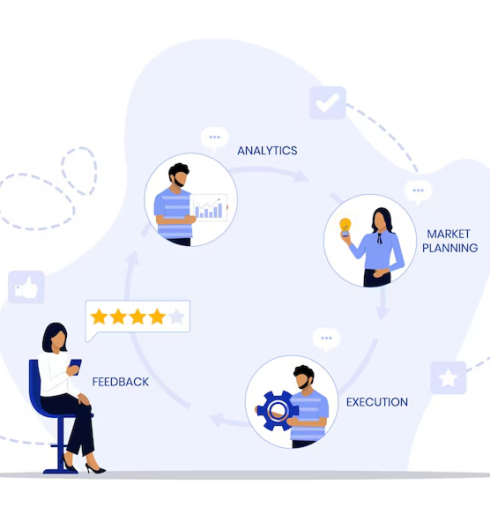Sep 20, 2024 .
By admin
Workflow Automation for Enterprises: Streamlining Operations for Maximum Efficiency
Introduction: Tackling Workflow Bottlenecks in Enterprises
In today’s fast-paced business environment, enterprises are increasingly looking for ways to optimize their workflows and eliminate inefficiencies. From order processing to customer service, enterprises often
struggle with workflow bottlenecks that can severely limit productivity and profitability. These challenges,
such as slow approvals, manual data entry, and disjointed communication, can impact the overall speed
and efficiency of business operations.
However, with the right approach to workflow automation, enterprises can achieve significant improvements
in speed, accuracy, and cost-efficiency. Whether you’re in the EU, Australia, or any part of the world,
workflow automation can help break down barriers, streamline operations, and scale your business
efficiently.
In this blog, we’ll guide you through the process of automating your workflows, highlight the benefits, and
provide actionable insights that can transform your enterprise into a more agile, data-driven organization.

Identifying and Prioritizing Workflow Bottlenecks
The first step in automating workflows is identifying where inefficiencies lie within your current business
processes. Whether it’s approval delays, repetitive manual tasks, or miscommunication between teams,
identifying these bottlenecks is crucial for effective automation.
Common Workflow Bottlenecks in Enterprises:
- Manual Data Entry: Redundant and error-prone tasks that consume valuable employee time.
- Approval Delays: Slow-moving approval cycles that hinder decision-making and operational efficiency.
- Communication Gaps: Disjointed communication between departments leading to delays and confusion.
- Inventory Management: Lack of real-time visibility on inventory levels and order tracking.
- Customer Support: Long response times due to manual query handling and tracking.
The Benefits of Workflow Automation for Enterprises
Implementing workflow automation offers significant benefits, allowing businesses to optimize operations,
reduce manual errors, and improve decision-making. The resulting benefits can be felt across various departments, from HR and finance to customer service and sales.
Key Benefits of Workflow Automation:
- Increased Efficiency: Automation streamlines processes, saving valuable time that can be allocated to higher-value tasks.
- Improved Accuracy: By reducing human error, automation ensures higher quality and accuracy in data processing and decision-making.
- Cost Reduction: With automated workflows, enterprises can cut down on labor costs associated with manual tasks.
- Faster Decision-Making: Automated processes allow teams to make faster and more informed decisions, improving the speed of business operations.
- Enhanced Customer Experience: Workflow automation ensures quicker response times and more efficient customer support, leading to higher satisfaction.


Selecting the Right Workflow Automation Tools
Once bottlenecks are identified, the next step is to choose the right automation tools. The type of
automation software you choose will depend on the complexity of your workflows and the specific
processes you want to automate.
Key Automation Tools and Solutions:
- Robotic Process Automation (RPA): RPA tools are ideal for automating repetitive, rule-based tasks such as data entry, invoice processing, and document management.
- usiness Process Management (BPM): BPM software helps automate and optimize entire business processes, integrating different departments and ensuring smoother workflows.
- Customer Relationship Management (CRM): Automating lead generation, follow-ups, and customer data management within your CRM.
- Enterprise Resource Planning (ERP): ERP systems automate financial processes, inventory management, and resource planning, helping enterprises operate more efficiently.
- AI-Powered Automation: For more complex automation tasks, AI tools can help with predictive analytics, decision-making, and process optimization.
How to Begin Your Workflow Automation Journey
Starting with workflow automation can be overwhelming, but it’s essential to approach it in a structured and
phased manner. A clear roadmap will help you implement automation successfully, ensuring that the tools
and processes work well together.
Step-by-Step Approach to Implementing Workflow Automation:
- Assess Your Current Workflows: Map out your existing processes, identifying inefficiencies and areas where automation can have the greatest impact.
- Define Key Objectives: Set clear goals for automation, such as reducing manual errors, speeding up approval cycles, or improving inventory management.
- Choose the Right Tools: Select the appropriate automation tools based on the needs of your business and the specific workflows you want to automate.
- Start Small: Begin with a few critical workflows and automate them in phases. This will allow you to measure success and adjust your strategy as needed.
- Monitor and Optimize: Continuously monitor the results of your automation efforts. Measure key performance indicators (KPIs) such as time saved, cost reduction, and error rates, and optimize your processes as necessary.
Measuring the ROI of Workflow Automation
The true value of automation lies in the tangible improvements it brings to business operations. As you
integrate automation into your workflows, it’s crucial to track the ROI to ensure that the investment is
delivering measurable results.
Key Metrics to Track:
- Time Savings: How much time is saved through automation? Can employees spend more time on high-value tasks?
- Cost Savings: What are the cost reductions associated with workflow automation, including labor, errors, and overhead?
- Quality Improvement: Has the accuracy and consistency of processes improved with automation?
- Employee Satisfaction: Are employees more satisfied with their work due to less manual, repetitive tasks?
- Customer Satisfaction: Has customer experience improved through faster service and responses?
Overcoming Common Challenges in Workflow Automation
While the benefits of workflow automation are significant, enterprises often face challenges in implementing
new systems. These challenges include resistance to change, integrating with existing tools, and ensuring
proper training and support.
Overcoming Automation Challenges:
- Employee Buy-In: Ensure that employees understand the benefits of automation and are involved in the process from the start.
- Seamless Integration: Choose automation tools that integrate well with your existing software infrastructure to minimize disruptions.
- Change Management: Provide adequate training and support to help teams adapt to the new automated processes.
- Continuous Improvement: Automation is not a one-time effort. Continuously monitor, optimize, and adapt your automation efforts as your business evolves.
The Future of Workflow Automation in Enterprises
As automation continues to evolve, enterprises are expected to adopt more sophisticated tools powered by
AI, machine learning, and cloud technologies. The future of workflow automation will likely see even greater
efficiency, enabling businesses to automate more complex tasks, predict operational trends, and drive
proactive decision-making.
Emerging Trends in Workflow Automation:
- AI-Powered Automation: Leveraging AI to automate complex decision-making, predictive analysis, and dynamic workflow adjustments.
- Cloud Automation: Cloud-based automation solutions that provide greater scalability and flexibility, making it easier for businesses to expand their automation efforts.
- End-to-End Automation: Integrating automation across all business functions from sales and marketing to finance and HR to create truly seamless workflows.
Conclusion: Transforming Your Enterprise with Workflow Automation
In today’s highly competitive business environment, workflow automation is a critical tool for enterprises
looking to improve efficiency, reduce costs, and scale operations. By automating key business processes,
you can eliminate bottlenecks, improve decision-making, and ultimately drive growth.
Are you ready to unlock the full potential of your enterprise through workflow automation? Reach out to us to learn more about how we can help streamline your operations, reduce inefficiencies, and drive
long-term success.
Let’s Start Automating. Contact us today to discuss how we can tailor a workflow automation solution that fits your business needs and accelerates growth.
